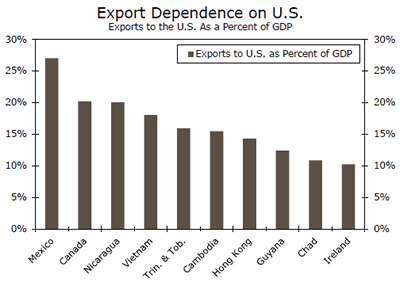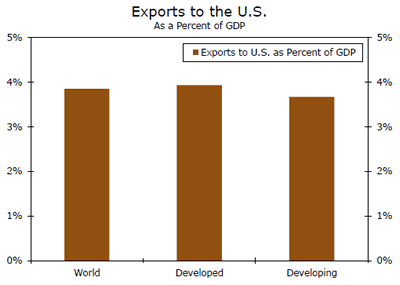U.S. Review
Confidence is Key
- The week was packed with key economic data releases and speeches by Federal Reserve officials. Survey-based economic data continued to point to improved economic conditions and expectations, though hard data have yet to deviate from trend.
- Throughout the week, several reliably-dovish Fed speakers indicated openness to increasing rates as early as the March 15 meeting. All eyes turned to a Friday afternoon speech by Yellen for hints. Markets now expect a 96 percent probability for a hike in March.
Will They Stay or Will They Go?
The economic calendar was packed with data releases this week, and speeches by Federal Reserve officials continued to prep the markets for an increase in interest rates "relatively soon." Market expectations have responded, with the Fed fund futures pricing in a 96 percent probability that the Fed will raise rates at the March 15 meeting. The tone shift among dovish Fed officials this week was notable, which we cover in detail in the Interest Rate Watch section of this report. Strong survey-based data readings were also notable this week, but the hard economic data were less so.
The factory sector continues to put the rough patch from 2015 through mid-2016 behind it. The ISM manufacturing composite rose to 57.7 in February, which is the highest since 2014. All of the sub-indices either rose further into expansionary territory or, in the case of order backlog, turned positive after months in the red. The survey’s measure of prices also continued to signal inflation pressures on a broad range of inputs beyond just oil prices. The new orders component of the survey surged to a three-year high, pointing to a much improved outlook for the sector than this time last year. Advance estimates of durable goods orders in January were softer, as core goods orders fell 0.4 percent to start the year, though December’s reading was revised upward. January’s stall in goods orders may be just temporary and, given the broad strength in the survey data, we expect continued firming in 2017.
The second release of Q4 GDP reiterated that the economy is driven by the consumer. The headline 1.9 percent growth was unchanged, but personal consumption contributed more than first reported while government and private investment added less. The post-election bump in consumer confidence held up in February, according to the Conference Board. Consumers were more confident about both the present situation and conditions going forward. Consumers’ assessment of the present situation now stands at its cycle high, as fewer people reported that current conditions were "bad" or that jobs were "hard to get." The share reporting "good" conditions or "plentiful" job opportunities also edged down slightly. The share that expected better business conditions and more jobs six months from now did rise, however.
Consumers’ confidence was not as obvious in the January income and spending data, however, although inflation certainly was. Disposable income rose 0.3 percent in January and spending was up 0.2 percent, although the story reversed when adjusted for inflation. Real disposable income and consumption expenditures declined in January. While January’s soft print may have been an aberration, it bears watching, particularly if economic growth is to accelerate as expected in the current consumer-led GDP growth environment. Meanwhile, inflation continues to accelerate. The PCE deflator, the Fed’s preferred measure of price growth, is honing in on the 2 percent target, with headline PCE up 1.9 percent over the year and core PCE up 1.7 percent in January. The case for a March rate hike can indeed be made, though it may be prudent wait for data to confirm that optimism translated into real economic growth in the first quarter of 2017.
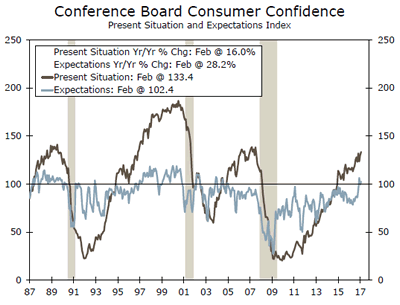
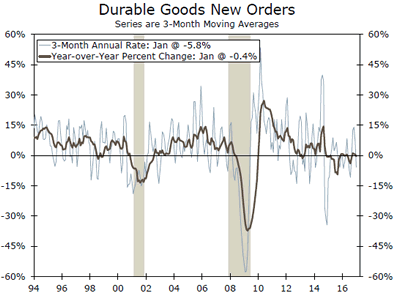
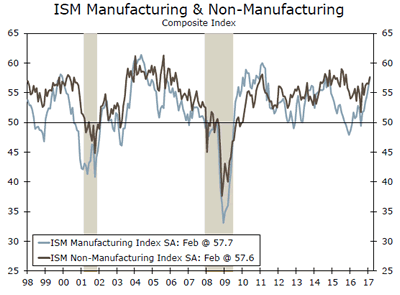
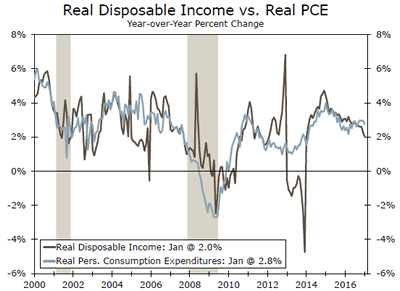
U.S. Outlook
Factory Orders • Monday
Signals from the factory sector have been encouraging in recent months, with continued improvement in the ISM manufacturing index and regional Federal Reserve Bank surveys. The advance estimate of January durable goods orders suggested the sector began 2017 on a bit of soft note relative to the prior month, but the general trend continued to edge higher. Shipments of non-defense capital goods ex-aircraft, a proxy for current business spending, fell 0.6 percent in the advanced estimate for January. Orders of core goods, a gauge of future capex plans, also fell but an upward revision to December’s reading puts the three-month annualized rate at 8.9 percent, suggesting improvement is in the offing.
We expect continued firming in the U.S. factory sector in the months ahead. We look for factory orders to post a gain of 1.1 percent in January.
Previous: 1.3% Wells Fargo: 1.1% Consensus: 1.0% (Month-over-Month)
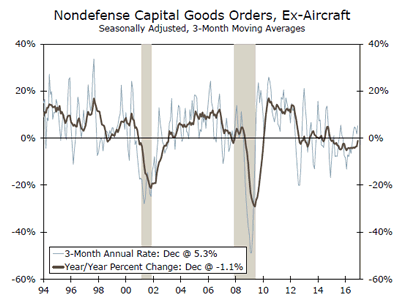
Trade Balance • Wednesday
The trade deficit narrowed in December. Imports rose by $3.5 billion, but exports grew even faster, rising just over $5 billion. The net result was a larger-than-expected narrowing in the trade deficit for the final month of 2016. The industries that contributed most to the surge in exports in December were capital goods and industrial supplies. Drilling into the sub-categories, we find that aircraft was a big factor in December. Civilian aircraft exports increased more than $1 billion and engines for those planes added another $978 million.
The advance goods trade balance data for January showed a surprisingly large $4.8 billion widening in the trade gap to -$69.2 billion. The trade deficit for Dec. was revised slightly lower to -$64.4 billion. Nominal goods exports fell 0.3 percent while nominal goods imports rose 2.3 percent. We expect the services surplus to widen slightly, to yield an overall deficit of -$48.7 billion.
Previous: -$44.3B Wells Fargo: -$48.7B Consensus: -$47.0B
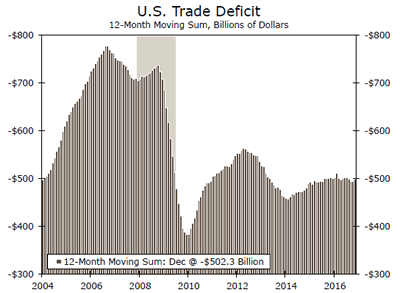
Employment • Friday
Nonfarm payrolls rose a solid 227,000 in January, boosting the three month average to 183,000. Gains were strong across the private sector, with payrolls rising 237,000 versus a pullback of 10,000 jobs in the public sector. The jobless rate ticked up to 4.8 percent. The U-6 rate, the broadest measure of unemployment, also rose as more workers reported working part-time for economic reasons. On the wage front, average hourly earnings rose at a slower-than-expected pace, likely due to the composition of hiring, as job growth was concentrated in lower-paying industries.
Most employment measures remain solidly positive. Jobless claims continue to trend near multi-decade lows and the employment components of both ISM surveys signal another solid print for payrolls. We expect to see that U.S. employers added 210,000 jobs in February and expect the jobless rate edged down to 4.7 percent.
Previous: 237,000 Wells Fargo: 210,000 Consensus: 185,000
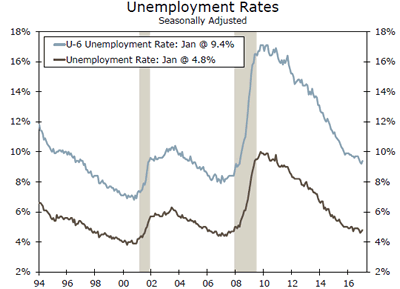
Global Review
Winter in Canada, Summer in Australia, Both Are Hot
- After a run of better-than-expected economic data, the Bank of Canada this week weighed in on faster inflation and correctly forecasted that GDP, which printed later in the week, would beat expectations.
- The Australian economy posted a faster-than-expected pace of expansion in the fourth quarter, handily bouncing back from a decline in growth in the prior period.
- It may not sound like much, but a 0.1 percent rate of core CPI inflation in Japan is incremental progress for the Bank of Japan and its efforts to stoke growth in consumer prices.
Australian GDP: Don’t Call It a Comeback, Mate
After declining in the third quarter of 2016, Australian GDP growth bounced back in the fourth quarter, expanding at an annualized pace of 4.4 percent, which was ahead of the consensus expectation. Both consumer and business spending contributed to the increase with a smaller boost coming from net exports. The strength in private sector demand and trade factors offset modest drags from a retrenching in government spending and a slight decline in inventories.
Various measures of business conditions in Australia like the NAB business confidence and business conditions surveys are both at multi-year highs, which suggests capital outlays should continue to underpin growth in 2017. The same cannot be said about Aussie consumer confidence, and although the jobless rate remains low at 5.7 percent, hourly wage growth has slowed. On that basis, we have a more measured outlook for consumer spending in the year ahead.
Amid Canadian Winter, Things Are Heating Up
The Canadian economy has been on a bit of a hot streak with a number of indicators (particularly job-related measures) beating consensus expectations. In fact, in February, the Citi economic surprise index for Canada hit its highest level since 2015.
The Bank of Canada (BoC) met this week, and after announcing a decision to keep rates on hold at 0.50 percent, the accompanying note addressed some of the recent firming in inflation and the Canadian economy. To the extent that market watchers were anticipating a sooner-than-expected rate hike out of the BoC, the statement threw cold water on any of those expectations. It said the inflation surge was likely transitory and that growth would remain under pressure and would remain on hold.
To its credit, the BoC correctly anticipated that fourth-quarter GDP figure releases later in the week would exceed expectations. Canadian real GDP grew at an annualized rate of 2.6 percent with big contributions to growth coming from trade and yet another increase in consumer spending. Business investment fell for the ninth straight quarter as Canada continues to absorb a lower price environment for oil and other commodities.
After so many consecutive declines, we expect Canadian business investment to pick up now that prices have stabilized somewhat, but we remain concerned about elevated consumer debt levels and what that debt implies about the sustainability of consumer spending in Canada.
Japanese CPI
The Bank of Japan (BoJ) has been exploring new frontiers in monetary policy accommodation in its bid to achieve the elusive goal of a 2.0 percent inflation target, which it has pledged to overshoot. A core inflation rate of 0.1 percent may not sound like much, but in Japan it represents the fastest rate of core CPI inflation since 2015 and an indication of progress for the BoJ. The headline inflation rate climbed to 0.5 percent. The BoJ cannot afford to let up, but things are moving in the right direction.
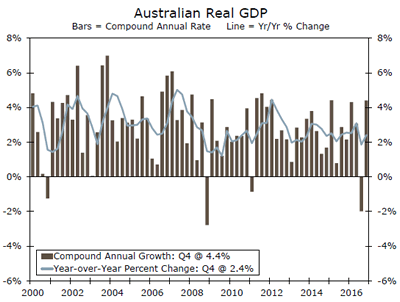
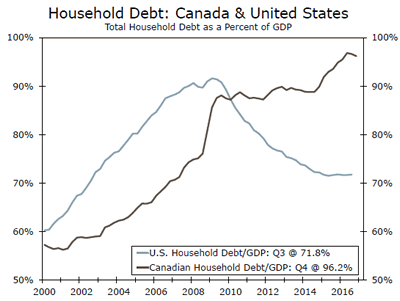
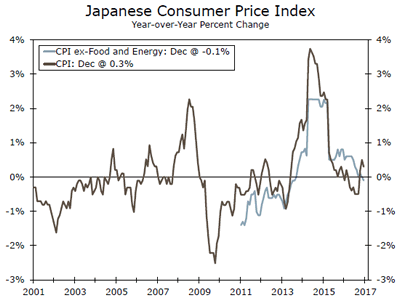
Global Outlook
Brazilian GDP • Tuesday
The Brazilian economy remained mired in a deep recession in Q3-2016, falling 0.8 percent quarter over quarter. This bested market expectations of a 0.9 percent decline—marking the seventh consecutive quarterly decline in economic activity. Year over year, the economy has contracted at a 2.9 percent pace. Some of the deterioration was expected due to the effects of the Olympic Games during that quarter. On the output side of GDP, transportation was the weakest sector, plunging 7.4 percent year over year, and the allimportant manufacturing sectors fell
3.5 percent. On the demand side of the economy, the external sector was again the only sector with a positive contribution to real GDP growth.
By the end of 2016, we expect the Brazilian economy to have contracted for an eighth straight quarter and to have declined at a 2.2 percent year-over-year pace.
Previous: -2.9% Wells Fargo: -2.2% Consensus: -2.6% (Year-over-Year)
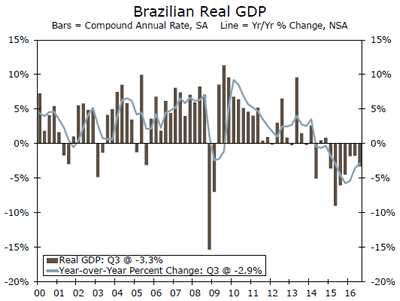
U.K. Industrial Production • Friday
Industrial production (IP) in the United Kingdom rose 1.1 percent in December compared to activity in November and grew 4.3 percent year over year. During the month, manufacturing was the only contributor to overall IP growth, increasing 2.1 percent, due to an increase in pharmaceuticals, metals and transportation equipment production. Moreover, manufacturing output grew 4.0 percent year over year—the fastest pace since April 2014. For January, markets are expecting a slowdown in year-over-year growth as surveyed manufacturing purchasing managers have indicated fewer new orders and a decline in backlogs.
Additional data on the docket next week include the U.K.’s January’s trade balance reading, which narrowed in December due to an increase in exports of goods to non-EU countries.
Previous: 4.3% Consensus: 3.0% (Year-over-Year)
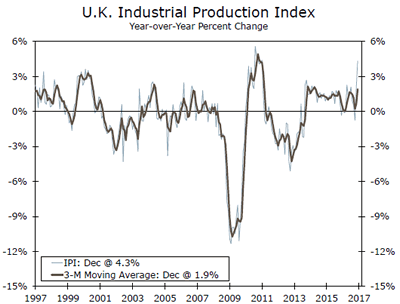
Canadian Employment • Friday
Employment growth in Canada has been strong in recent months, with non-farm payrolls rising by 48,300 in January. The month’s gains came on the tails of a strong December reading of 54,000 jobs. That said, Canadian monthly employment figures are notorious for being volatile, but it is quite clear that the trend is heading higher. In January’s employment report nearly all of the growth was in part-time jobs, increasing by 32,400, while full-time positions had a smaller gain of 15,800. The unemployment rate ticked back down to 6.8 percent, despite the labor force participation rate increasing to 65.9 percent. Depressed wage growth, which increased 1.0 percent—its slowest pace since April 2003—remains a concern for the Bank of Canada.
Other data slated to be released next week include January’s housing starts figures, which has seen double-digit annual gains for the past two months.
Previous: 48,300
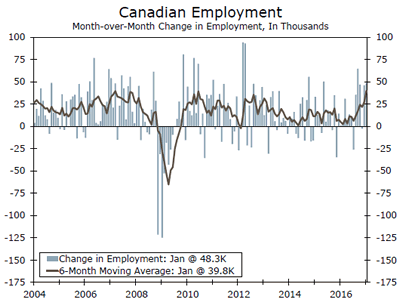
Point of View
Interest Rate Watch
Markets Get Their Marching Orders
A slew of Fed-speak this week led markets to drastically reprice the possibility of the FOMC raising interest rates at its next meeting on March 15. At the start of the week, futures probabilities according to Bloomberg implied a 40 percent chance of rate hike at the Fed’s next meeting, but that has since risen to 96 percent.
What explains the jump? The logical place to start would be the data. From the perspective of the Fed’s mandates, the most important report of the week was the PCE deflator. Headline inflation, at 1.9 percent, rose by the most since 2012, but core inflation was unchanged at 1.7 percent. Other "hard" data on core capex orders, Q4 GDP revisions and real consumer spending disappointed.
Despite the hard data showing little change in the trend for growth, Fed officials look increasingly content with the economy’s outlook. What has changed has been the "soft" data. Consumer confidence, the ISM indices and small business optimism have reached multi-year highs and suggest that Fed members feel "animal spirits" will boost growth until details on fiscal policy emerge.
Notable this week were comments from Bill Dudley, who said the case for "tightening has become a lot more compelling." Lael Brainard, arguably the most dovish member on the Committee, also stated removing more accommodation would be "appropriate soon." Capping things off was a speech by Chair Yellen. Speaking about the March meeting, she said that as long as employment and inflation continue to evolve in line with expectations, "further adjustment of the federal funds rate would likely be appropriate."
Even though the hard data hasn’t changed much in recent weeks and details on fiscal policy remain scant, the reaction to comments this week may have boxed the committee into raising rates in March. With markets giving the Fed the green light to raise rates—whether measured by the implied rate futures or the fresh highs in equities—passing on March could jeopardize the Fed’s still-fragile credibility with markets.
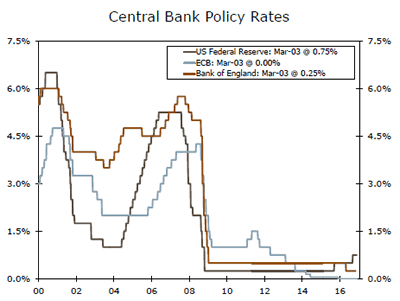
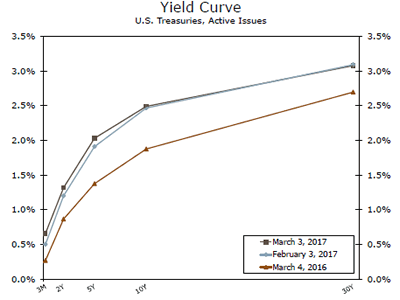
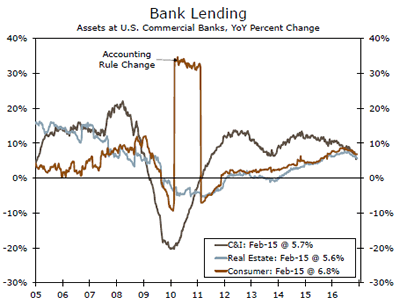
Credit Market Insights
Homeowners Withdraw Less Equity
U.S. home prices have risen roughly 45 percent since reaching a bottom in 2011 according to data from CoreLogic. Homeowner equity has risen in kind, increasing nearly $7 trillion over the same period.
Despite the steady run-up in home prices, very few homeowners have been tapping into their housing equity relative to the numbers observed during the 2006 housing boom. According to research from the Federal Reserve Bank of New York, from 2000 to 2006, homeowner equity and extraction of equity both rose rapidly. In fact, from 2003 to 2007, homeowners were withdrawing more than $350 billion per year for a variety of uses from spending on home improvement to consumption. In comparison, as home prices recovered from 2012 to 2016 homeowner equity withdrawal rates averaged well below $50 billion per year.
The decline in equity extraction is due to a range of factors, including tighter credit standards following the housing crisis and older and more creditworthy borrowers’ decreasing propensity for equity withdrawal. This shift in the way consumers leverage their housing wealth has been a primary factor in household deleveraging. Mortgage and home equity debt have fallen meaningfully since 2008 and both account for a smaller share of overall household debt. The more cautious approach to leveraging is a positive sign for consumers’ financial stability.
Topic of the Week
Border Adjustment Tax: Affected Countries
The prospect of a border adjustment tax (BAT) has been introduced as part of the White House administration’s potential business tax reform. The specific BAT being discussed would apply a 20 percent tax on all imports into the U.S. On the flip side, U.S. exports of goods and services would not be taxed. We are not taking a position on whether the BAT is desirable/undesirable; rather we are looking at what countries would be most affected by such a policy. To measure a country’s economic dependence on the U.S. as an export market, we have calculated the ratio of a country’s exports to the U.S. to that same country’s GDP.
Unsurprisingly, the U.S.’s NAFTA partners, Mexico and Canada, top the list, with exports to the U.S. representing 27.0 percent and 20.2 percent of their respective GDPs (top graph). However, apart from the convenience that a shared border provides for trade, geographic location does not seem to play a significant role in determining a country’s dependence on the U.S. as an export market. For instance, of the top 10 exportdependent countries, two are in North America, three are from Central and South America, three are from Asia, one is from Africa and one is from Europe. Moreover, it appears that the top 10 countries that would potentially be most affected by the BAT do not fit a specific profile with regard to development. In the aggregate, developed nations’ exports to the U.S. represent 3.9 percent of their total GDP, while developing countries’ exports comprise 3.7 percent of their collective GDP (bottom graph).
While a border-adjustment tax of the nature being discussed would certainly affect our neighbors to the immediate north and south disproportionately, such a policy would have almost universal trade implications. Many countries that are generally not considered essential trading partners from the U.S. perspective, such as Chad, are themselves heavily dependent on the U.S. as an export market. Examining such a trade policy from the other side, that is from the perspective of foreign nation exporting goods and services to the U.S. allows us to better anticipate the potential trade disruptions should such a policy be enacted.
